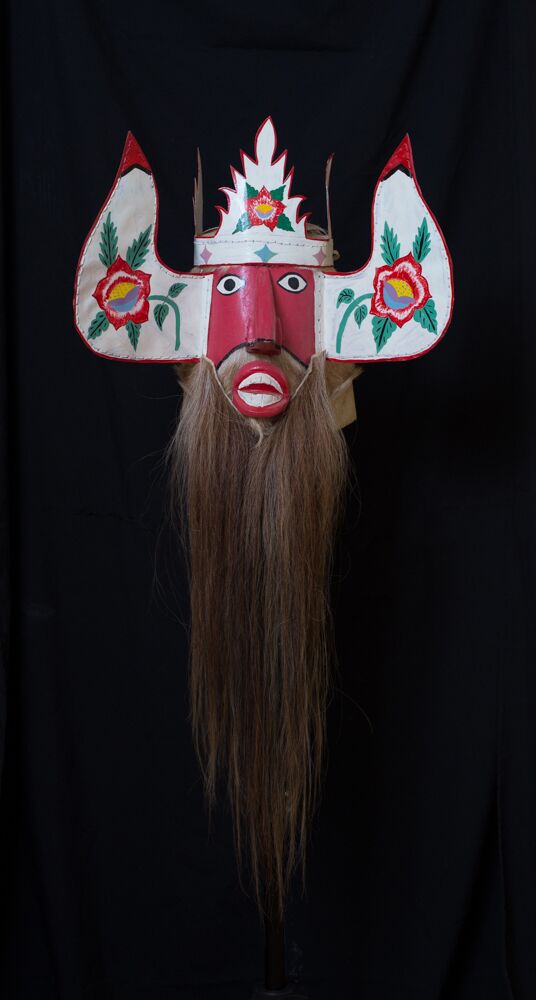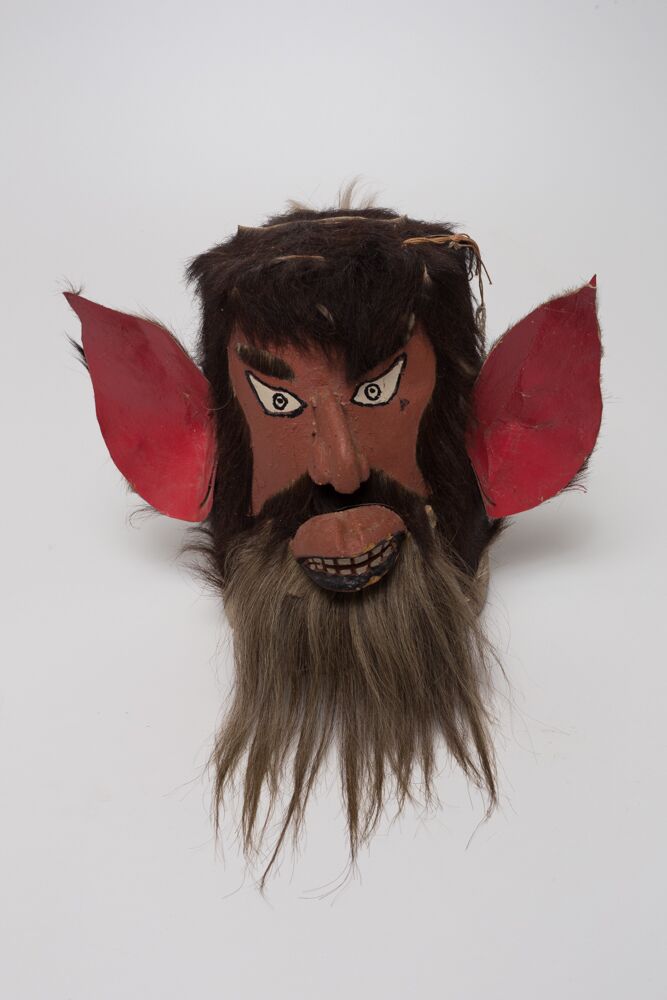-
 Máscara de pascolaDownload
Máscara de pascolaDownload
Pascola mask handcrafted using the technique of soft wood type chiricote or chilicote painted with enamel. In the upper part of the forehead he wears a cross for the protection of those who carry it and expressing the indigenous converted to the Catholic religion (cultural syncretism). Wearing the mask for the dance symbolizes the male goat, known as yoem chupia (bewitched or bewitched man). On his cheekbones he has painted the figure of a yo'awa from the Juya ánia universe (animal from the universe of nature, since the Yaqui feels part of that universe. In this case it is a lizard. On the outer contour, there is a decoration formed by triangles in white and red colors to represent the sacred hills of the Yaqui territory. The word Pascola is etymologically composed of two words from the Yoeme language: pajko which means party and oola which means old; the combination of both words translates as the old man or the wise man of the party. In the dance, the Pascolas represent the movements of the animals of the Juya Ania universe, among which the lizard stands out; the chameleon; the male goat and the toad. It is common to hear the Pascolas shout during the procession with the image of the Saints, trying to call the evil one because they feel that he has abandoned them because of their prayers.
Metadata
Title
Pascola Mask
Alternative title
Pajko’ola maajka
Creator
Yaqui tribe
Created
1985
Type
Description
Physical object:
Dimensions 36 X 13 X 9.5 19.4 X 13 X 9.5 [36 X 13 X 9.5 cm.]
Leather technique
Description
Pascola mask handcrafted using the technique of soft wood type chiricote or chilicote painted with enamel. In the upper part of the forehead he wears a cross for the protection of those who carry it and expressing the indigenous converted to the Catholic religion (cultural syncretism). Wearing the mask for the dance symbolizes the male goat, known as yoem chupia (bewitched or bewitched man). On his cheekbones he has painted the figure of a yo'awa from the Juya ánia universe (animal from the universe of nature, since the Yaqui feels part of that universe. In this case it is a lizard. On the outer contour, there is a decoration formed by triangles in white and red colors to represent the sacred hills of the Yaqui territory.
The word Pascola is etymologically composed of two words from the Yoeme language: pajko which means party and oola which means old; the combination of both words translates as the old man or the wise man of the party. In the dance, the Pascolas represent the movements of the animals of the Juya Ania universe, among which the lizard stands out; the chameleon; the male goat and the toad. It is common to hear the Pascolas shout during the procession with the image of the Saints, trying to call the evil one because they feel that he has abandoned them because of their prayers.
Subject
Religion and culture--Sonora (Mexico : State)--Holy Week | Religious dance--Mexico | Sculpture--Mexico--Ethnic groups
Format
Still image / jpg
Spatial
Sonora , Cócorit
Temporal
1981 -1990
Is part of
Hall of traditional festivities, Museum of the Yaqui people
Provenance
Museum of the Yaqui people. Sinaloa and Obregon No. 200, Cocorit, Cajeme, Sonora
It has been part of the museum's collection since its creation in 1985.
Language
eng , yaqui
Date
2021-09-14
Identifier
Web Catalogación Obregón 2016 - 2308
ISC-CGPC-MY-0001
RS-OM-MEY-01
Relationship
Flute | Pascola Dancer Bells Belt | Violin | Harp | Pascola Drum | Moth Cocoon Ankle Rattles Pascola Length | Pascola dancer hand rattle | Deer dancer | Pascola dancer | Pascola dancer video
Contributor
Sonoran Institute of Culture
Casanova, Juan (photography)
Buitimea Flores, Teodoro; Ruiz Félix, José María (investigation)
Valencia, Carlos ; The Yaqui Pride Project (translation to english)
License

This work is licensed under a Creative Commons Attribution-NonCommercial-ShareAlike 4.0 International License.
Rights
Sonoran Institute of Culture


